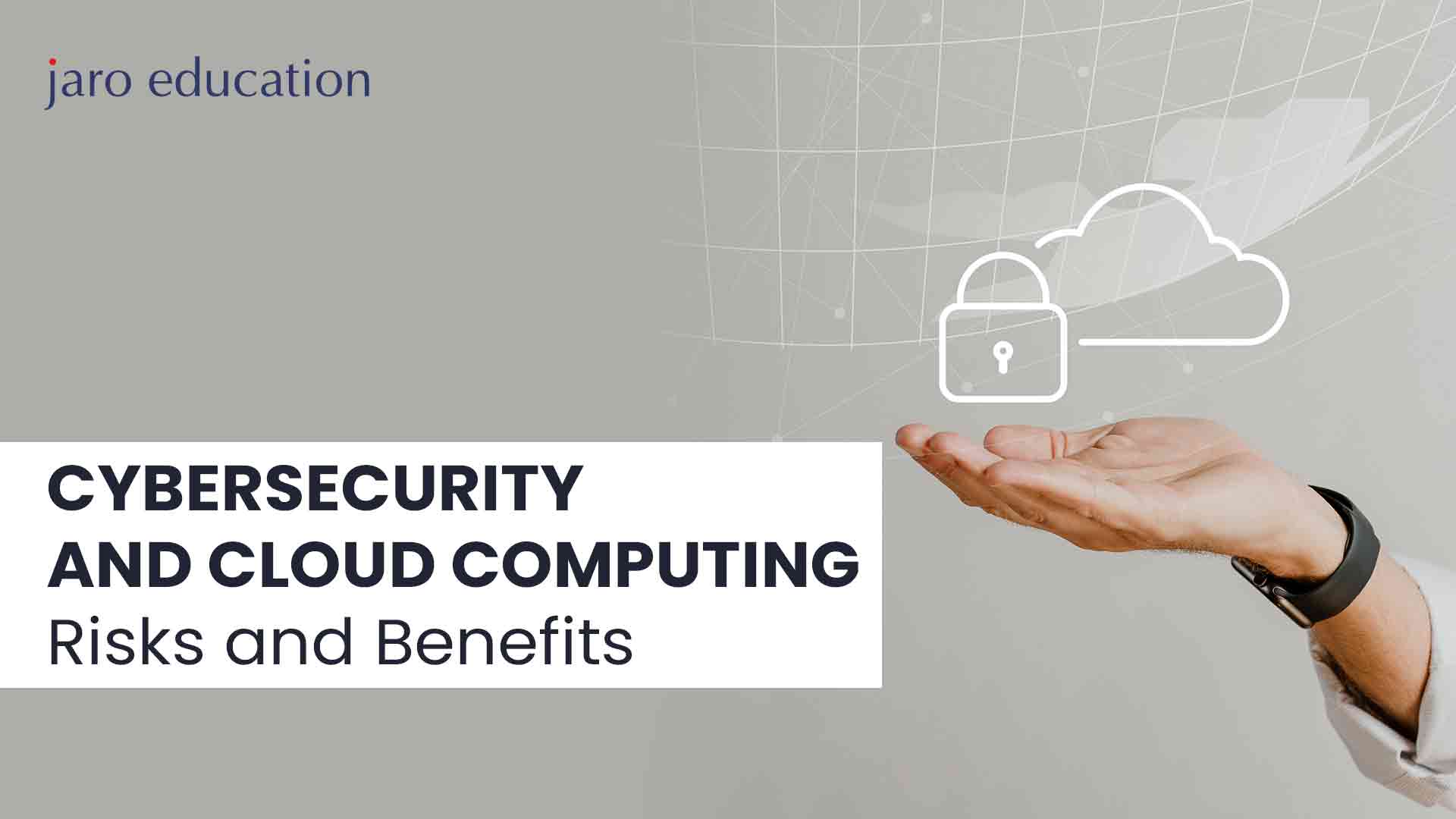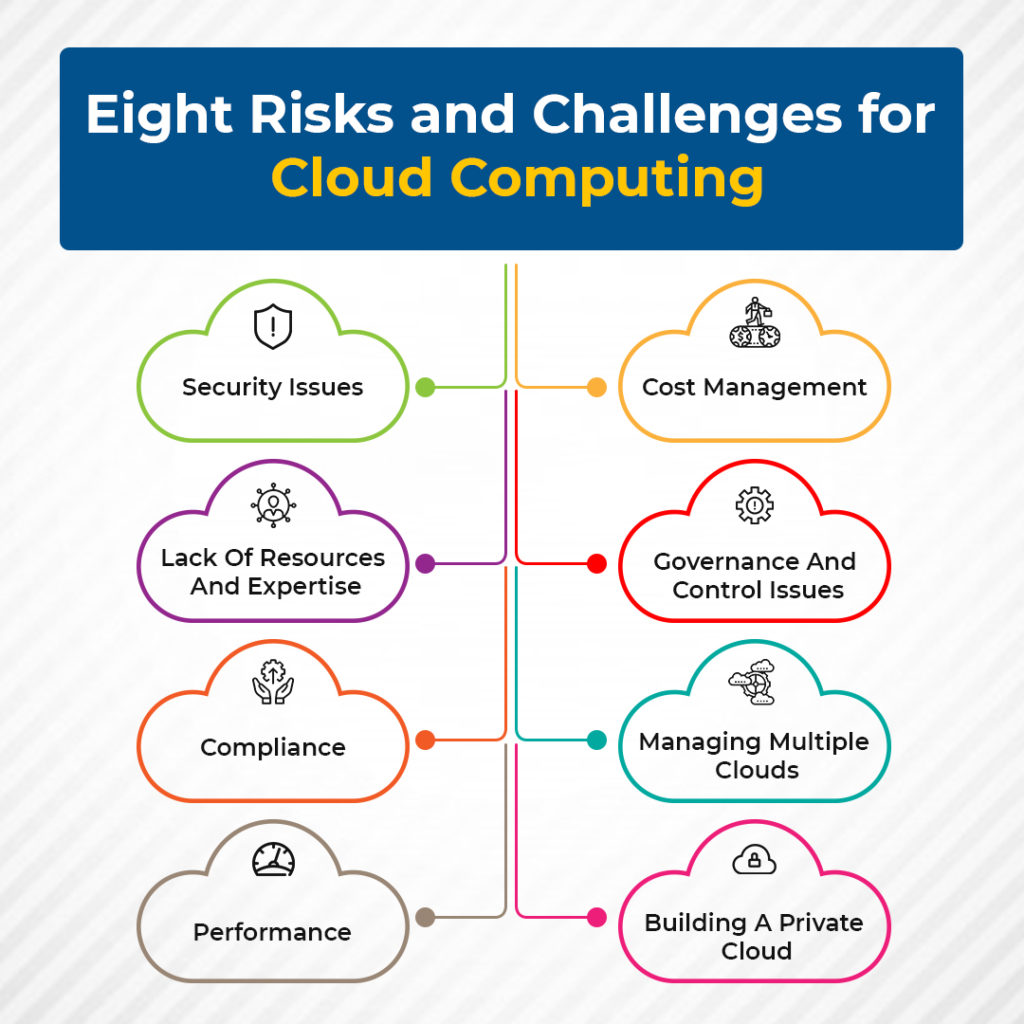
- jaro education
- 9, March 2024
- 10:00 am
In today’s digital age, cybersecurity and cloud computing go hand-in-hand. As more and more businesses adopt cloud solutions, securing data in the cloud becomes critically important. This blog discusses the common risks of cloud computing and how strong cybersecurity strategies can help reap maximum benefits from the cloud.
What is Cloud Computing?
Cloud computing refers to the on-demand delivery of IT resources and applications via the Internet rather than having local servers or personal devices handle applications. Instead of investing in costly hardware infrastructure and data centers, companies can leverage the massive economies of scale that cloud providers offer.
Some examples of popular cloud services are Amazon Web Services (AWS), Microsoft Azure, Google Cloud Platform, IBM Cloud, Alibaba Cloud, etc. These provide services around servers, storage, databases, networking, software, analytics and more to customers on a pay-as-you-go pricing model that scales up or down based on actual usage.
Risks of Cloud Computing
While adopting cloud computing and witnessing its immense advantages, organizations need to also thoroughly assess the cybersecurity risks involved before proceeding. Some of the key risks that must be evaluated are:
Table of Contents

*blog.skillmonks.com
Data Breaches
Storing sensitive proprietary data on public cloud servers always carries the tangible risk of data breaches through hacking, human errors or inherent system vulnerabilities being exploited. Once perimeter defenses are breached, lack of visibility into cloud infrastructure makes timely detection and response difficult.
Misconfigurations
The complexity of properly configuring security, access policies, controls and permissions across cloud platforms, networks and applications is immense. Even tiny misconfigured settings can unintentionally expose data or grant access to unauthorized parties. Identifying and fixing misconfigurations across dynamic cloud environments is challenging.
Exposure of APIs
Cloud services extensively use APIs (application programming interfaces) to enable smooth integration and interoperation between various systems, software, applications and services. However, exposed APIs that lack proper authentication or access restrictions can become a huge cyber risk – as attackers can exploit these to directly access backend cloud databases and resources.
Malware Propagation
Connected cloud environments where workloads, containers, functions and systems intricately interact allow malware and malicious code to propagate quickly across entire cloud networks once any endpoint or server is infected. Lateral movement once systems are compromised can rapidly spiral out of control.
Lack of Access Controls
Neglecting to define and implement strong identity and access mechanisms can potentially expose sensitive data to organization-wide security threats. It encompasses role-based access, password policies, multi-factor authentication, and the principle of least privilege access on cloud infrastructure.
Regulatory Compliance Pitfalls
The abstracted and distributed nature of public cloud infrastructure coupled with limited visibility into provider controls, practices and data management policies poses severe compliance risks for regulated industries. The inability to assess and ensure adherence to geographic data localization laws or industry-specific regulations related to data privacy, residency, security and governance can lead to heavy penalties.
Benefits of Cloud Computing
For organizations that adopt sound cloud cybersecurity strategies, the benefits of cloud computing far outweigh the risks involved:
1. Increased Business Agility
The on-demand nature and near real-time scalability of cloud infrastructure allow businesses to be more responsive to evolving opportunities.
2. Cost Efficiency
Cloud solutions significantly reduce upfront capital expenditure and ongoing operating costs for technology infrastructure and services.
3. Boosted Productivity
Cloud applications enhance collaboration and information sharing across the enterprise leading to gains in workforce productivity.
4. Quicker Innovation
The flexibility to spin cloud infrastructure and platforms rapidly accelerates prototyping and deploying new solutions to serve customer needs better.
5. Greater Reliability
Cloud platforms employed by leading providers deliver extremely high-reliability levels that surpass legacy on-premises systems.
6. Enhanced Resilience
Distributed cloud infrastructure offers built-in redundancy making systems more resilient to failures besides faster disaster recovery.
For most enterprises today, the question is not whether to adopt cloud computing but how soon and how securely. With strong cybersecurity defenses tailored for the cloud, companies can confidently embrace cloud solutions for transformative business impact.
Cloud Security - Best Practices
Cloud security tools mostly create a robust first line of defense, but organizations still need to uphold their end of shared responsibility for securing cloud data. Some best practices include:
Strict Access Governance
Organisations must maintain separate administrator accounts from standard business users with minimal privilege grants when managing access in the cloud. Enforcing multi-factor authentication across all types of cloud user accounts is also essential to restrict access. Businesses should also adopt a least-privilege model aligned to zero trust principles for provisioning user access in the cloud and regularly review user accounts as well as access permissions to minimize risks from dormant accounts or excessive privileges.
Continuous Security Monitoring
It is important for businesses to have granular visibility into user activities within cloud environments. This can be achieved through tools like Cloud Access Security Brokers. Additionally, VPN logs, API calls and network traffic patterns must be monitored to quickly detect anomalous activities that could indicate threats or breaches. Auditing administrator actions are also necessary to identify any unauthorized changes made to cloud platforms. Alos, implementing strict log audits for regular review further helps identify issues.
Resilient Data Backup Mechanisms
Maintaining recent backups of critical cloud data and workloads in secondary accounts or storage systems should be a key data protection strategy for businesses embracing the cloud. Testing the integrity and availability of cloud backups through mock restoration drills periodically is equally vital. Businesses must also ensure that the security of cloud systems hosting backups is at par with that of production systems.
Software Security Hygiene
It is important for IT and security teams to closely track security bulletins and firmware updates released for all cloud services in use and promptly install high-priority patches that fix vulnerabilities. Secure system configuration baselines must also be enforced across cloud infrastructure through tools like Cloud Security Posture Management.
Addressing Top Cloud Security Threats
Organisations looking to harness the power of cloud computing also need to address some of the most prominent risks of cybersecurity that target cloud environments:
Phishing Attacks
Phishing uses spoofed emails and fake websites to trick users into sharing login credentials or sensitive data. Cloud applications directly expose more users and data to phishing risks.
Key Mitigations:
- Enable multi-factor authentication
- Train employees to identify phishing attempts
- Use email security tools to detect phishing links and attachments
System Vulnerabilities
Undetected vulnerabilities in cloud platforms or unsupported legacy systems can allow attackers easy entry into cloud networks.
Ways to Mitigate:
- Regularly scan for vulnerabilities
- Update systems with the latest security patches
- Use cloud security tools to identify misconfigurations
Hacked APIs
APIs enable applications to interact with cloud services and data. Exposed or unsecured APIs can let attackers in.
Ways to Mitigate:
- Secure APIs with authentication tokens
- Carefully restrict API permissions
- Monitor API traffic for anomalies
Insecure Interfaces
Insecure web or mobile interfaces used to access cloud data can potentially allow unauthorized access.
Ways to Mitigate:
- Enforce strict password policies
- Implement multi-factor authentication
- Check user authorizations on every access request
Malicious Insiders
Cloud providers’ employees with privileged access can potentially access, modify or steal customer data.
Ways to Mitigate:
- Review people policies around access management
- Detect unusual user activities through cloud monitoring
- Demand transparency from providers on controls around insider threats
By addressing these and other threats proactively, companies can securely unlock innovation through cloud adoption while minimizing cybersecurity risks involved with cloud computing.
Cybersecurity Benefits for Cloud Adoption
While cyber risks are inherent in migrating applications or infrastructure to the public cloud, adopting robust security technologies and frameworks tailored specifically for cloud environments can help organizations securely unlock maximum benefits:
Centralised Visibility and Control
Cloud security tools provide centralized visibility as well as granular control across disparate cloud workloads, applications, data stores, services, networks and user activities through a single pane of glass. This unified view significantly simplifies securing, monitoring and responding to security threats or incidents.
Substantial Cost Savings
Specialised cloud security tools help drive down capital expenditures and ongoing operational expenses substantially compared to traditional on-premise security appliances by taking advantage of cloud efficiencies. Savings also stem from accelerated deployments and reduced need for skilled staff.
Advanced Protection from Emerging Threats
Leading cloud providers utilize advanced analytics capabilities including machine learning, artificial intelligence and updated threat databases to detect sophisticated zero-day malware, ransomware or distributed attacks rapidly and protect workloads.
Streamlined Regulatory Compliance
Continuous compliance monitoring, automated policy enforcement, activity logging and detailed audit reporting provided by cloud security platforms simplify adherence to strict industry regulations as well as provide compliance controls to auditors.
Minimized Impact of Attacks
The use of techniques like micro-segmentation and virtual containerization coupled with redundant failover mechanisms lower risk surface while facilitating quicker isolation and recovery when incidents do occur – thereby minimizing damage as well as data losses.
Robust Data Encryption
Encrypting sensitive data in transit as well as at rest using robust algorithms defends information from potential unauthorized access even in cases of insider risks or inadvertent exposure that may bypass other protections.
Context-aware Access Controls
Sophisticated identity and access management technologies control user access to specific resources based on their role and context. The adoption of zero-trust models maximizes cloud security.
Emerging Cloud Security Technologies
As cloud platforms, applications, and cyber threats continue advancing rapidly, innovative technologies have emerged to enhance cloud security:
Cloud Workload Protection Platforms (CWPP)
CWPPs offer unified visibility, protection and compliance across multi-cloud or hybrid-cloud environments. They do this by integrating various security tools like Cloud Security Posture Management (CSPM), micro-segmentation, firewalls, and more through a single pane of glass. Besides that, instead of managing different tools individually, security teams can manage, monitor and secure everything in one place.
Cloud Access Security Brokers (CASB)
CASBs essentially insert themselves into the cloud data flow between users and cloud application providers to monitor all activity and uniformly enforce security policies. Some key capabilities provided by CASBs include device profiling, data loss prevention, malware and threat detection, data encryption both in transit and at rest, and user behavior analytics to identify risky activities.
Cloud-Native Application Protection Platforms (CNAPP)
As modern applications utilize cloud-native architectures and containers, traditional security tools cannot provide sufficient protection. CNAPPs specifically focus on securing cloud-native applications by deeply integrating them into DevOps pipelines. They provide continuous visibility into risks, detect threats and anomalies through advanced analytics, and automatically correct cloud application misconfigurations before they can be exploited.
Managed Detection and Response (MDR)
MDR services leverage cutting-edge analytics including machine learning, artificial intelligence and updated threat intelligence to continuously monitor customer cloud environments, rapidly detect threats, analyze their severity, determine the right response actions, and perform containment and remediation around the clock without waiting for customer direction.
While still evolving rapidly, such next-generation cloud-native security technologies allow enterprises to confidently remediate risks, meet compliance needs, and fully leverage cloud benefits through enhanced cyber resilience tailored to modern infrastructures and application architectures.
Conclusion
Cloud computing introduces new dimensions of cyber risks that call for tailored security strategies spanning tools, processes and people. Whilst risks can never be eliminated, advanced cybersecurity technologies help organizations securely unlock innovation and business value from cloud adoption. Coupling robust cloud-based security with vigilant practices, enterprises can optimally balance the risks and benefits of cloud computing.
If you are looking to further advance your cyber security and data science skills, IIM Nagpur offers an outstanding PG Certificate Programme in Cyber Security Management and Data Science that will equip you with cutting-edge knowledge. This comprehensive course covers crucial topics like cyber security frameworks, data mining, machine learning, and more. Delivered by expert faculty, it provides valuable industry insights. Join India’s premier management institute and gain skills that will boost your career in our data-driven world. To apply, contact Jaro Education.









